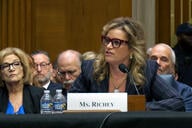You have /5 articles left.
Sign up for a free account or log in.

A mountain of Title IX complaints targeting single-sex programs in recent years has disrupted higher ed initiatives promoting women’s participation in STEM.
Photo illustration by Justin Morrison/Inside Higher Ed | Getty Images | Rawpixel
The Rochester Institute of Technology has a persistent and yawning gender gap—what some have called its “infamous gender ratio.” It is nearly two-thirds male, a number that has remained relatively stable for years, sometimes raising eyebrows among prospective female applicants.
RIT is not an anomaly. While the gender gap in higher education has narrowed to the point of reversal, with more women than men enrolling in college, STEM fields have remained stubbornly male-dominated: only 21 percent of engineering majors and 19 percent of computing majors are women, according to data from the National Science Foundation. Institutions that focus on STEM education often have similarly low numbers of female students.
That’s why RIT introduced a slate of programs and scholarships aimed particularly—and in many cases, exclusively—at women. They include a Women in Engineering at RIT (WE@RIT) group, as well as a series of summer and after-school programs designed to encourage high school girls to apply to RIT and enter STEM fields.
Such programs have also invoked the scrutiny of civil rights investigators. Critics of single-sex initiatives have filed complaints with the Education Department’s Office for Civil Rights, arguing that they violate Title IX of the Education Amendments of 1972, the law that prohibits discrimination on the basis of sex in federally funded education. Fourteen of RIT’s programs were the subject of one such complaint, filed in 2018, and a subsequent four-year investigation that closed just last month.
The complaint was dismissed, but only after RIT opened the programs to men. Officials also closed two of the programs during the course of the investigation, though a spokesperson for RIT said that was unrelated to the probe.
The RIT spokesperson wrote in an email that there “was no investigation” into the programs, but documents from OCR officials indicate an investigation was opened in 2019. The spokesperson explained in a follow-up email that the complaint had been “dismissed”—language also used by the OCR in its September letter—and thus found invalid.
Mark Perry, an emeritus professor of economics at the University of Michigan at Flint, filed the complaint that opened the RIT investigation. A passionate crusader against what he sees as higher education’s double standard for gender discrimination, Perry said RIT’s women in STEM programs were “obviously in violation of civil rights law.”
“RIT made significant changes, changes that would not have been made if not for the investigation,” he said. “In my opinion this is clearly a finding of guilt, even if they’re not calling it that.”
But the legality of single-sex programs may not be as clear-cut as Perry believes. In fact, though colleges often choose to alter eligibility requirements in the face of federal investigations, the OCR has ruled in favor of some exclusive women-in-STEM programs.
Notably, in March the OCR concluded an investigation into Kettering University’s Lives Improve Through Engineering and Science, or LITES, a two-week summer program exclusively open to high school girls—and found it in compliance with civil rights law. The OCR accepted Kettering’s argument: that the program was a “recruitment tool” and a “corrective measure” to the university’s historical discrimination against women, which has led to a student body that today is only 22 percent female.
Kettering’s victory could embolden other colleges to take a similar defensive tack instead of capitulating to accusations of discrimination. But just how applicable Kettering’s case may be to other institutions—and how willing they are to take on the legal risk of fighting an OCR complaint—remains to be seen.
‘The Same Old Circus’
In response to the OCR investigation, Women in Engineering at RIT changed its eligibility requirements to include “male allies,” said Kathy Ehrlich-Scheffer, the program’s director. She doesn’t anticipate the shift will have much impact on the program but said the onslaught of complaints against women-in-STEM initiatives underscores their very importance—especially at technical colleges where the culture is still heavily male-dominated.
“So often our women students are among only a handful of women in their engineering classes; sometimes they are the only woman in class,” she wrote in a statement to Inside Higher Ed. “While our male allies may opt into or out of any WE@RIT program or event without any harm done, our women students can’t opt out of class and still earn an engineering degree regardless of how uncomfortable they may feel by the uneven gender dynamics at play.”
Perry believes that targeted programming—even if allowed under Title IX—won’t remedy the uneven gender dynamics. Federal and institutional investments in closing the STEM gender gap have been “a failed social experiment … to brainwash girls and women to go into engineering and computer science,” he said.
The reason so many more men than women are in STEM, Perry ventured, is not historical discrimination or social expectations, but rather “a natural difference in the wiring” between the sexes.
“It could be that women just aren’t as interested in math and science, or that men have more of an aptitude for highly quantitative fields,” he said.
Kristen Seversky, an RIT graduate who studied computer science, said Perry’s attitude is common among men in STEM programs and helps contribute to the very gender disparity it seeks to dispel.
“I grew up with four brothers, so I always believed I could do everything they could,” she said. “What really shifted my understanding as a woman was, honestly, going to RIT.”
She recounted being one of a handful of women in her computer science classes, a major with even more gender disparity than other engineering fields; in 2016 only 16 percent of RIT’s computer science degree seekers were female. For the first time in her life, Seversky felt hesitant to express herself. Many of the other women in the program switched majors or transferred schools, she said; by the time she graduated, she was one of six women in her cohort who’d made it all the way through.
“That’s why these programs exist, and why they’re so important,” she said. “It’s not discrimination against men. We’re trying to focus on the people who are not represented. If anything, these guys are overrepresented.”
Since graduating in 2009, Seversky has helped found a now-defunct nonprofit to help more women get into tech fields, and she has also mentored undergraduates through the Women in Computing at RIT program. But she said resistance to such initiatives has only increased; male protesters have showed up to several Women in Computing events in recent years.
“It’s the same old circus, the same song and dance,” she said. “I don’t believe the people issuing these complaints or disrupting our events are really motivated by equality. It’s about grievance and attrition, and it can really wear you down.”
A ‘Full-Time’ Crusade
Alexandra Brodsky, a campus civil rights attorney with the nonprofit legal advocacy group Public Justice, linked the campaign of Title IX complaints against women-in-STEM initiatives to the surge in similar complaints about race-based discrimination in minority-only programs following the Supreme Court’s June decision striking down affirmative action. The key difference, she said, is that it’s motivated by misogyny rather than racial grievance.
“These complaints are part of a movement to use civil rights laws to undermine civil rights in America, and it’s really being driven by a handful of dudes with an ax to grind,” she said.
Perry has been grinding his ax for years. For him, reporting colleges for what he sees as reverse discrimination—whether on the basis of sex or race—isn’t just a hobby; it’s a “full-time gig.”
He first took up what he calls his “moral and ethical calling” in 2016, when he heard about a women-only lounge at Michigan State University, a few dozen miles from his home in Flint. He called it “gender apartheid” and, after contacting the school’s legal counsel about his civil rights concerns, got it converted to a coed space.
Since then he has become a serial filer of Title IX complaints: over the past six years he has issued thousands of informal grievances to universities’ offices of legal counsel and filed more than 800 official civil rights complaints with the Department of Education.
Every university official and Title IX lawyer contacted for this article recognized Perry’s name immediately, often responding with an exasperated sigh or eye roll. Some had interacted with him personally over the years; all said his persistent filings have made their jobs more difficult.
“If his work weren’t so offensive, it would be laughable,” said Betsy Homsher, Kettering’s Title IX coordinator.
But his work is also effective. Of the hundreds of Title IX complaints Perry has filed, the vast majority have resulted in an OCR investigation and, eventually, some kind of change to the targeted program or scholarship, according to ample documentation Perry provided. Whether those changes are purely cosmetic—a Women’s Early Career Research Award at the University of Minnesota removing “Women’s” from its name, for instance—or more substantial, the complaints spur university counsel to get involved, at times discouraging greater investment in the programs.
Resisting the Urge to ‘Throw in the Towel’
Universities tend to concede quickly to the demands in Perry’s Title IX complaints, especially if they’re coupled with an OCR investigation. But a small number have pushed back—and won.
When Kettering University was informed that the OCR had opened an investigation into its LITES program a few years ago, Homsher, who founded LITES in 2002 and ran it for 10 years, said university leaders backed her in fighting aggressively against changing the program.
“It never occurred to us to throw in the towel,” she said.
The university laid out an argument tracing Kettering’s gender disparity to its days as the School of Automotive Trades and, later, the General Motors Institute; women weren’t allowed to enroll until 1965. The LITES program was part of a broader effort to correct for that discrimination, they said.
Furthermore, they argued that LITES was a recruiting tool for the university. Homsher said nearly half of all program participants have ended up at Kettering, and that each year for the past two decades, an average of 7 percent of new female students have been LITES alumnae.
Donald Rockwell, Kettering’s lead counsel, said that while he never had any doubts about the righteousness of their position, winning “took a tremendous amount of work.”
Even Perry admitted that part of the reason Kettering succeeded was because officials actually tried.
“Kettering was very determined,” he said. “No other university really puts that much effort into defending these programs.”
For Homsher, that’s half the problem.
“I know big university lawyers. In most cases when a complaint comes through, they don’t want to deal with it,” she said. “They just want to do whatever they can to take it off the docket.”
Brodsky said the legal rationale that buoyed the Kettering decision isn’t likely to hold for most institutions. While many OCR findings of violation wouldn’t hold up in an actual courtroom, she said plenty of colleges are wise to make immediate concessions.
“When you have a gender-lopsided STEM-focused school, it’s often hard to differentiate between how much of that is caused by social problems versus the institution’s own mess,” she said.
The OCR’s Kettering decision has had a demonstrable impact on morale, however. Laurie Mezaros Dearolf, executive director of the Perry Initiative (no relation to Mark), an organization that offers female-only programs encouraging women to become orthopedic surgeons, said the Kettering resolution has helped her shift conversations with the universities she works with—some of whom have received Title IX complaints from Perry about their partnership—away from appeasement.
“The Kettering letter has been great for us,” she said. “It’s emboldened more institutions to start thinking differently about how to respond to these complaints.”
Brodsky said the legal framework is still amorphous, especially after the Supreme Court’s ruling on affirmative action. Colleges with race-conscious scholarships and bridge programs are scrambling to interrogate their legality and adjust accordingly.
Unlike race-exclusive programs, over which courts must exercise strict scrutiny, sex-based programs are subject to a more flexible, “intermediate” scrutiny, Brodsky said, and in many cases are entirely legal. Correcting a history of discrimination against women, for instance, could be a valid defense; so could proving that men have equal opportunities through other university-funded programs. That makes litigating the issue of sex-conscious programming much trickier.
“It will be interesting to see how the [Students for Fair Admissions] case affects Title IX,” Brodsky said. “Right now, it’s an open question what’s allowed and what’s not.”
Perry is determined to force an answer to that question, and he doesn’t plan on letting any judgment in favor of “blatant discrimination” stand. A few days after the OCR ruled in favor of Kettering, Perry filed an appeal. He filed a similar appeal two years ago in a ruling that found a women-only program at the University of New Mexico to be compliant with civil rights law—and succeeded in reversing that decision.
He said he’s confident the Kettering appeal will go the same way.





